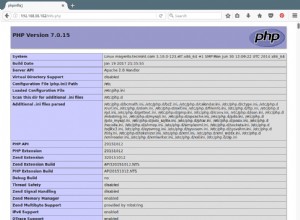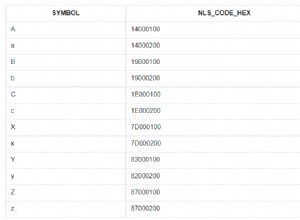Encontré una respuesta en línea y actualicé la pregunta en esta página para mostrarles a otros cómo se hace.
ACTUALIZACIÓN - PROBLEMA SOLUCIONADO
En primer lugar, había creído erróneamente que la tabla de origen (la que está en formato de listas adyacentes) debía modificarse para incluir un nodo de origen. Este no es el caso. En segundo lugar, encontré una clase a través de BING que hace el truco. Lo modifiqué para PHP5 y convertí los bits relacionados con mysql del autor original a PHP básico. Estaba usando alguna clase DB. Puede convertirlos a su propia clase de abstracción de base de datos más adelante si lo desea.
Obviamente, si su "tabla de origen" tiene otras columnas que desea mover a la tabla de conjuntos anidados, deberá ajustar el método de escritura en la clase a continuación.
Con suerte, esto salvará a alguien más de los mismos problemas en el futuro.
<?php
/**
--
-- Table structure for table `adjacent_table`
--
DROP TABLE IF EXISTS `adjacent_table`;
CREATE TABLE IF NOT EXISTS `adjacent_table` (
`id` int(11) NOT NULL AUTO_INCREMENT,
`father_id` int(11) DEFAULT NULL,
`category` varchar(128) DEFAULT NULL,
PRIMARY KEY (`id`)
) ENGINE=MyISAM DEFAULT CHARSET=latin1 AUTO_INCREMENT=8 ;
--
-- Dumping data for table `adjacent_table`
--
INSERT INTO `adjacent_table` (`id`, `father_id`, `category`) VALUES
(1, 0, 'Books'),
(2, 0, 'CD''s'),
(3, 0, 'Magazines'),
(4, 1, 'Hard Cover'),
(5, 1, 'Large Format'),
(6, 3, 'Vintage');
--
-- Table structure for table `nested_table`
--
DROP TABLE IF EXISTS `nested_table`;
CREATE TABLE IF NOT EXISTS `nested_table` (
`lft` int(11) NOT NULL DEFAULT '0',
`rgt` int(11) DEFAULT NULL,
`id` int(11) DEFAULT NULL,
`category` varchar(128) DEFAULT NULL,
PRIMARY KEY (`lft`),
UNIQUE KEY `id` (`id`),
UNIQUE KEY `rgt` (`rgt`)
) ENGINE=MyISAM DEFAULT CHARSET=latin1;
*/
/**
* @class tree_transformer
* @author Paul Houle, Matthew Toledo
* @created 2008-11-04
* @url http://gen5.info/q/2008/11/04/nested-sets-php-verb-objects-and-noun-objects/
*/
class tree_transformer
{
private $i_count;
private $a_link;
public function __construct($a_link)
{
if(!is_array($a_link)) throw new Exception("First parameter should be an array. Instead, it was type '".gettype($a_link)."'");
$this->i_count = 1;
$this->a_link= $a_link;
}
public function traverse($i_id)
{
$i_lft = $this->i_count;
$this->i_count++;
$a_kid = $this->get_children($i_id);
if ($a_kid)
{
foreach($a_kid as $a_child)
{
$this->traverse($a_child);
}
}
$i_rgt=$this->i_count;
$this->i_count++;
$this->write($i_lft,$i_rgt,$i_id);
}
private function get_children($i_id)
{
return $this->a_link[$i_id];
}
private function write($i_lft,$i_rgt,$i_id)
{
// fetch the source column
$s_query = "SELECT * FROM `adjacent_table` WHERE `id` = '".$i_id."'";
if (!$i_result = mysql_query($s_query))
{
echo "<pre>$s_query</pre>\n";
throw new Exception(mysql_error());
}
$a_source = array();
if (mysql_num_rows($i_result))
{
$a_source = mysql_fetch_assoc($i_result);
}
// root node? label it unless already labeled in source table
if (1 == $i_lft && empty($a_source['category']))
{
$a_source['category'] = 'ROOT';
}
// insert into the new nested tree table
// use mysql_real_escape_string because one value "CD's" has a single '
$s_query = "
INSERT INTO `nested_table`
(`id`,`lft`,`rgt`,`category`)
VALUES (
'".$i_id."',
'".$i_lft."',
'".$i_rgt."',
'".mysql_real_escape_string($a_source['category'])."'
)
";
if (!$i_result = mysql_query($s_query))
{
echo "<pre>$s_query</pre>\n";
throw new Exception(mysql_error());
}
else
{
// success: provide feedback
echo "<p>$s_query</p>\n";
}
}
}
mysql_connect('localhost','USER','PASSWORD') or die(mysql_error());
mysql_select_db('DATABASE') or die(mysql_error());
// build a complete copy of the adjacency table in ram
$s_query = "SELECT `id`,`father_id` FROM `adjacent_table`";
$i_result = mysql_query($s_query);
$a_rows = array();
while ($a_rows[] = mysql_fetch_assoc($i_result));
$a_link = array();
foreach($a_rows as $a_row)
{
$i_father_id = $a_row['father_id'];
$i_child_id = $a_row['id'];
if (!array_key_exists($i_father_id,$a_link))
{
$a_link[$i_father_id]=array();
}
$a_link[$i_father_id][]=$i_child_id;
}
$o_tree_transformer = new tree_transformer($a_link);
$o_tree_transformer->traverse(0);
?>
Aquí está la salida:




